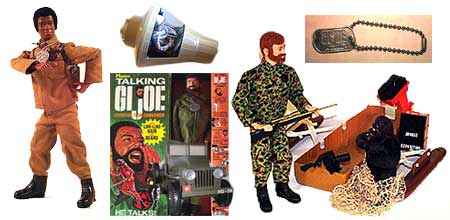G.I. Joe (60's, 70's)

Synopsis of Toy
There are two truths in the world of 12-inch toy figures: Barbie is the queen of dolls, and G.I. Joe is the king of action figures. Long before 80's kids knew G.I. Joe as “A Real American Hero,” the original 12-inch G.I. Joe figures helped popularize the idea of the action figure with their cool features and nifty playsets. In the process, they paved the way for other 12-inch action figures like the Six Million Dollar Man and became some of the most famous and beloved toys of all time.
The G.I. Joe story began in 1963 when a marketing man approached the Hasbro toy company with the idea of creating a poseable soldier to promote a television show called The Lieutenant. Although the company didn’t take the deal, they decided to create a soldier-based action figure. Designers at Hasbro developed a 12-inch figure whose 21 moveable parts allowed it to take on a variety of lifelike poses. They named the finished doll G.I. Joe after the film The Story Of G.I. Joe.
In 1964, G.I. Joe hit the toy market like a howitzer shell. The initial line of toys contained 75 different items that covered four different types of recruit—soldier, marine, sailor and pilot. Toy buyers were impressed by these ambitious toys and began snapping them up like mess hall hotcakes as Hasbro continued to flesh out the G.I. Joe toy line with new soldiers and accessories. New soldiers from this time included the Green Beret and the Deep Sea Diver. There was also a G.I. Nurse, which did not sell well during its release but is an in-demand collectible today. As for accessories, there was no shortage of cool items like the Five Star Jeep and the Mercury Space Capsule. By 1968, there were even talking G.I. Joe figures.
The sales of G.I. Joe began to falter as the 1960’s neared their end, and Hasbro decided to rework the line to stay current with the times. Due to the Vietnam War, soldiers were no longer hip in the public eye, so the G.I. Joe shifted from ‘soldier’ to ‘adventurer.’ G.I. Joe’s adventures took him a variety of new places: the jungle, the hidden tombs of mummies, even outer space. He explored these new realms with four new compatriots that were collectively known as the Adventure Team. This team also boasted its own cool line of vehicles with a distinctive “AT” logo, the coolest being a Jeep with a working winch that allowed the Jeep to tow other vehicles.
The public took to the new Adventure Team, skyrocketing sales to a level that even the original G.I. Joe toys didn’t reach. To keep up with sales, the folks at Hasbro continued to add new items and cool features. One of the most beloved features added during this time was the famous "kung fu grip." Basically, all this meant was that the figure’s hands were flexible rubber, but the feature’s cool name ensured that every male kid added “G.I. Joe with the kung-fu grip” to his Christmas wish list.
Another cool feature introduced around this time was "life-like hair," tiny fibers that were painstaking stitched into the figure’s head in place of the traditional painted-on hair. The only problem with this hair was its tendency to fall out after enduring enough wear and tear. Today, collectors can turn to special toy-repair services to get new hair patched into their classic G.I. Joes, but no such thing existed for kids back in the day. Thus, the owners would either have to paint on new hair or learn to live with their now-mangy-looking G.I. Joe.
During the mid-1970’s, G.I. Joe sales began to dip. Hasbro counteracted this by borrowing from the television hit The Six Million Dollar Man to create a bionic warrior called Mike Power, Atomic Man. He was half-man and half-robot, complete with a mechanized arm, a mechanized leg, and a “flashing atomic eye.” It was a hit with toy buyers, notching up a million sales in less than a year. Other new characters introduced in the wake of Atomic Man included Bulletman, the first superhuman G.I. Joe character, and Eagle Eye, a figure with eyes that could move. These new heroes needed a new set of enemies, and they quickly received them in The Invaders, a nasty group of aliens with “crusher grip” arms.
The new Adventure Team toys did not sell as well as Atomic Man, and the G.I. Joe toy line ran into further trouble when the Arab oil embargo of the mid 1977’s made the large amounts plastic to make G.I. Joes very costly. Hasbro dealt with these problems by discontinuing the Adventure Team toy in favor of a new line of 8-inch toys called Super Joe. These figures had a science fiction theme, complete with reptilian alien enemies and spaceship-style figures. They were well-designed but did not catch on with the public. By 1978, the lack of big sales and the rising price of plastic caused Hasbro to stop making G.I. Joe toys.
The 1980’s saw G.I. Joe make his triumphant return. In 1982, G.I. Joe was reintroduced in a smaller, molded-plastic style. These toys hit it big with toy buyers, helped in part by a popular G.I. Joe cartoon series and a new comic book from Marvel Comics. These smaller G.I. Joe toys continue to be made today, and their enduring success led to the revival of the 12-inch figures in the mid-1990’s. The G.I. Joe Classic figures were introduced in 1992 and became an instant success with the baby-boomers who treasured the original G.I. Joe toys. They continue to be made today and sell steadily at toy stores, proving that G.I. Joe is still the king of action figures.
Release History of Toy
1964 - G.I. Joe (12")1982 - G.I. Joe (3 3/4")
